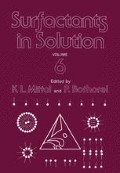Abstract
The present work deals with the study of water-methylene chloride microemulsions stabilized with an active blend composed of sodium p-octylbenzenesulphonate as surfactant and a series of linear alcohols from propanol to heptanol as cosurfactant. The oil was chosen because of its ability to solubilise water-insoluble compounds which offers potential use in organic electrochemistry. The pseudoternary mass phase diagrams were determined at room temperature for a cosurfactant to surfactant mass ratio equal to 2. They display an isotropic phase area whose shape and size depend greatly on the alcohol and seem to be related, to a great extent, to the capacity of the microemulsions for solubilizing water. Viscosity and conductivity measurements show that the fluidity of the microstructures decreases when the alcohol chain length increases with an abrupt change from pentanol to hexanol. An attempt to better understand the structure and dynamics of the microemulsions has been made by electrochemical measurement of the diffusion coefficients of two electroactive probes: an oil-soluble one (N-methyl phenothiazine) and a water-soluble one (hydroquinone). The measured diffusion coefficients are comparable in their values and their variations to the expected self-diffusion coefficients of methylene chloride and water respectively, and thus provide valuable information about the composition of the continuous and disperse phases. Our results demonstrate once again the relation between the structure of the microemulsions and the nature of the alcohol cosurfactant. The comparison between the behavior of our water-CH2Cl2 system and the well-known waterdodecane system seems to confirm that the influence of the alcohol chain length is invariant with respect to the oil type. More significant features relating the microemulsion structure to the nature of the cosurfactant would be based on the role of the cosurfactant on the fluidity of the structure; it would depend on the mutual solubility of the compounds, the alcohol/surfactant molecular ratio which decreases from propanol to heptanol and a steric and concentration effect of the alcohol on the interphase curvature and flexibility.
Access this chapter
Tax calculation will be finalised at checkout
Purchases are for personal use only
Preview
Unable to display preview. Download preview PDF.
References
W. B. Gogarty, J. Pet. Tech., 28, 93 (1976).
V. K. Bansal and D. O. Shah in “Micellization, Solubilization and Microemulsions”, K. L. Mittal, Editor, Vol. 1, Plenum Press, New York, 1977.
R. E. Barden and S. L. Holt in “Solution Chemistry of Surfactants”, K. L. Mittal, Editor, Vol. 2, p. 707, Plenum Pres, New York, 1979.
R. A. Mackay, Adv. Colloid Interface Sci., 15, 131 (1981)
R. A. Mackay, in “Microemulsions”, I. D. Robb, Editor, p. 207, Plenum Press, New York, 1982.
C. De Bourayne, M. T. Maurette, E. Oliveros, M. Riviere, A. De Savignac and A. Lattes, J. Chim. Phys., 79, 139 (1982).
A. Gonzales, J. Murphy and S. L. Holt, in “Inorganic Reactions in Organized Media”, S. L. Holt, Editor, ACS Symposium Series No. 177, Washington, 1982.
G. Mathis, D.Sc. Thesis, 1982, Nancy, France.
A. Xenakis and C. Tondre, J. Phys. Chem., 87, 4737 (1983).
P. Fourre, D. Bauer, and J. Lemerle, Anal. Chem, 55, 662 (1983).
A. Berthod and J. Georges, J. Chim. Phys., 80, 245 (1983).
L. E. Scriven, Nature (London), 263, 123 (1976).
B. Lindman, P. Stilbs and M. E. Moseley, J. Colloid Interface Sci., 83, 569 (1981).
B. Lindman, N. Kamenka, T. M. Kathopoulis, B. Brun and P. G. Nilsson, J Phys. Chem., 84, 2485 (1980).
E. W. Kaler and S. Prager, J. Colloid Interface Sci., 86, 359 (1982).
J. Heil, M. Clausse, J. Peyrelasse and C. Boned, Colloid Polymer Sci., 260, 93 (1982).
C. Boned, M. Clausse, B. Lagourette, J. Peyrelasse, V. E. R. McClean and R. J. Sheppard, J. Phys. Chem., 84, 1520 (1980).
M.Clausse, J. Heil, J. Peyrelasse and C. Boned, J. Colloid Interface Sci., 87, 584 (1982).
V. K. Banasal, D.O. Shah and J. P. O’Connell, J. Colloid Interface Sci., 75, 462 (1980).
P. Stilbs, K. Rapacki and B. Lindman, J. Colloid Interface Sci., 95, 583 (1983).
H. Stephen and T. Stephen, “Solubility of Inorganic and Organic Compounds”, Vol. 1. Part 1, Pergamon Press, 1983.
J.C. Russel and D. G. Whitten, J. Am. Chem. Soc., 104, 5937 (1982).
E. W. Kaler, K. E. Bennett, H. T. Davis and L. E. Scriven, J. Phys. Chem., 79, 5673 (1983).
M. Dvolaitzki, M. Lagues, J. P. Le Pesant, R. Ober, C. Sauterey and C. Taupin, J. Phys. Chem., 84, 1532 (1980).
P. Stilbs and B Lindman, J. Colloid Interface Sci., 99, 290 (1984).
P. Stilbs, J. Colloid Interface Sci., 87, 385 (1982).
J. Georges and S. Desmettre, Electrochim. Acta, 29, 521 (1984).
A. M. Bellocq, J. Biais, B. Clin, P. Lalanne and B. Lemanceau, J. Colloid Interface Sci., 70 ,524 (1979).
P. G. De Gennes and C. Taupin, J. Phys. Chem, 86, 2294 (1982).
D. J. Mitchell and B. W. Ninham, J. Chem. Soc. Faraday Trans. II, 77, 601 (1981).
Author information
Authors and Affiliations
Editor information
Editors and Affiliations
Rights and permissions
Copyright information
© 1986 Plenum Press, New York
About this chapter
Cite this chapter
Georges, J., Berthod, A., Arnaud, N. (1986). Physico-Chemical Study of Water/Methylene Chloride Microemulsions: Effect of Alcohol Cosurfactant. In: Mittal, K.L., Bothorel, P. (eds) Surfactants in Solution. Springer, Boston, MA. https://doi.org/10.1007/978-1-4613-1833-0_27
Download citation
DOI: https://doi.org/10.1007/978-1-4613-1833-0_27
Publisher Name: Springer, Boston, MA
Print ISBN: 978-1-4612-9024-7
Online ISBN: 978-1-4613-1833-0
eBook Packages: Springer Book Archive

